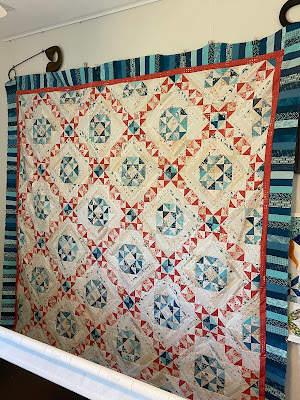I prepared this post in 2021, but never completed it.... I guess some things, like the subject of this post, just take time!!
This quilt began with fabric I found at a quilt shop in Laramie, WY on a trip from Denver to San Francisco in 2017. Yes, you read that correctly! I collected fabric at several stops on the trip, not even knowing what I wanted to do with it. It wasn't until another adventure, this time a workshop in New Hampshire in 2018, that I found the pattern I wanted to use! Bonnie Hunter's String Fling" has a quilt called "Jamestown Landing". I thought it would look great in teals, and decided I also wanted to add some soft orange colors. The hunt continued!

Quilts take fabric. Lots of fabric. A twin-size quilt requires 7 yards of fabric, plus or minus, just for the top. If the quilt is comprised of lots of tiny pieces, you may even need more because 1/2 inch of every piece, either width and length, are lost in the seam allowances. I decided to make this as a king, which requires over 10 yards of fabric! This particular quilt is what we call "scrappy" for obvious reasons. So, collecting fabric continued, As I visit shops I look for fabrics in the right colors, and add a quarter yard here and a quarter yard there. Some of my fabrics were featured in quilts I previously used and some I inherited from my mother.
Half-square triangles, or HSTs (sounds like a venereal disease!) make up over half the pieces in the quilt. An HST is a square made of two triangles sewn along the diagonal. For this quilt the squares are 2 1/2". It takes a lot of HSTs to make a king size quilt! At one point, while sewing, and sewing, and sewing, a song came to mind. You can sing along to the tune of "Seasons of Love":
Five hundred, twenty-five thousand, six hundred HSTs,
That's how many I have to sew.
Five hundred, twenty-five thousand, six hundred HSTs,
I probably have a thousand to go!
You cut them,
You piece them,
You sew them together.
You press them,
You trim them,
And stack them up high.
I began making HST's in mid to late January. The finished "flimsy" was on my wall on April 2, 2021.
"Strings" of triangles sewn together
HST's in stacks, ready to be pieced together
Here I have placed HST's on the quilt wall to view placement of colors
HST's are sewn together to make blocks
Blocks of different sizes are sewn together to make the quilt
I knew I wanted a "piano key" outer border, but here I am "auditioning" different fabrics for a smaller inner border, trying to decide which looks best.
When I complete the "flimsy" I often hang it up on one of the walls in my sewing room. This lets me enjoy the almost finished quilt, and also helps me decide what quilting patterns I want to use.
However, before the quilt can be quilted, I need to prepare backing. I enjoy using scraps from the quilt to make a pieced backing. It's almost as much fun as putting the top together!
Once the top and backing are complete I can put the fabrics on my long arm sewing machine, making a "sandwich" with the backing on the bottom, the batting in the middle and the quilt top on the top layer. The fabrics are rolled onto separate rollers on the machine, so the fabric may be held taut for stitching.

Sometimes I am not quite sure what design I want to use for different portions of the quilt. I have a piece of plexiglas that I can put on top of the quilt while it is on the long arm which I can use to try out different pattern ideas.
After the quilting is finished the only thing left to complete the quilt is to put a binding on the raw edges of the quilt. I usually sew the binding on by machine, and finish it with hand stitching.
Adding a label to the quilt is also part of the process. This label was sewn into the backing of the quilt. Other labels are hand stitched to the back after the quilting is complete.
The quilt is then ready to use or to gift to someone!
















